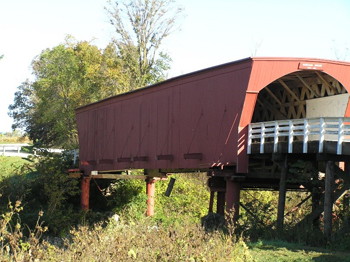InTrans / Aug 12, 2014
Preserving America’s historical covered bridges
Go! Magazine
 posted on August 12, 2014
posted on August 12, 2014
Covered timber bridges are one of the most iconic images of rural America. Covered timber bridges, also often referred to as “barn bridges,” originated in the northeastern United States, although the idea of covering bridges came from Europe.
History
During the 1800s, industrialization was just beginning in the United States. As a result, it lead to an increased need and demand for bridges to move materials and people across the thousands of rivers and streams that crossed America. Timber was a readily available and economical resource and the material of choice at this time for building bridges to allow for goods and people to traverse rivers and streams. No two bridges were exactly the same, though there were a handful of common designs, and each was built entirely by hand (this era was before power tools and heavy machinery existed). Covered timber bridge building was so prevalent that there were almost 10,000 covered bridges by the early 1900s.
Main Features
Outside of the walls and roof, the most prominent feature of covered timber bridges are the trusses used to support both the weight of the bridge itself and the travelers moving across them. The trusses are what give each subgroup of covered bridges their name, i.e. Howe Covered Bridges (use Howe trusses), Queen-post Covered Bridges (use Queen-post trusses), Town Lattice Covered Bridges (use Town Lattice trusses), etc. Covering timber bridges with walls and a roof protect the part that supports weight (the timber structural members) from the elements. Being protected, covered timber bridges are estimated to last up to five times longer than bridges without covering and even longer with regular maintenance and upkeep.

“In some cases, the bridges are strong enough that they can handle a small car, and often more than that if the geometrical limitations of the entrance of the structure weren’t so limiting,” said Travis Hosteng, a bridge research specialist at Iowa State University’s Institute for Transportation.
Concerns
By the early 1900s, the building of covered timber bridges decreased drastically. The introduction of iron, steel, and concrete bridges allowed for bigger, wider, and longer bridges that could support more weight than timber bridges. To make way for these new bridges, many covered timber bridges were demolished or moved to new locations, others were left to rot, and many were destroyed intentionally by vandals. A few, though not many, were retrofitted, often with steel, to support the weight of modern vehicles. Today, less than 800 covered timber bridges remain in the United States. There are many current efforts to restore and upkeep the bridges, and protect them from being destroyed deliberately by arsonists.
“The big issue is vandalism and arson,” said Hosteng. “Security is just as big an issue as them deteriorating.”

Hosteng recently completed a project in Madison County, Iowa to assess effective ways to increase the security of covered bridges.
“We came up with two different cameras, a flame detector, and other sensors,” said Hosteng. “It’s fully automated. If it detects something like a flame, the police, fire department and a few specific others are immediately and automatically alerted. It worked. We caught two or three people out there.”
As a result of that research, a security manual, advising bridge owners on the best security practices, will soon be published through the Unites States Department of Agriculture’s Forest Products Lab in Madison, Wisconsin. The manual will list options and offer some suggestions for preserving bridges against vandalism and arson. Bridges that are destroyed, either by natural disaster or willful destruction, are sometimes rebuilt, though these are highly expensive due to very few people having the expertise or knowledge to replicate the method used to build the originals These icons of American history are lost at a rate of about five per year. Most rot away due to years of neglect while others are willfully destroyed by vandals and arsonists. The originals, some of which are almost 200 years old, are irreplaceable.
By Brandon Hallmark, Go! Staff Writer